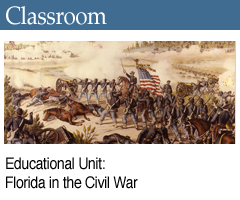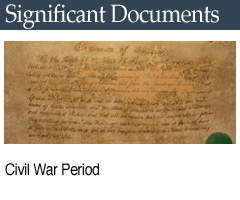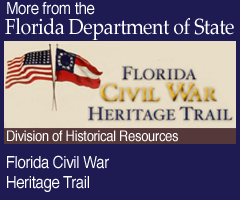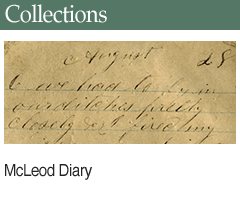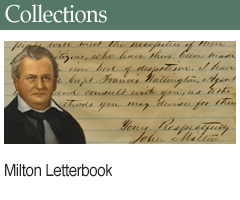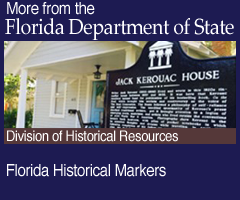A Guide to Civil War Records
at the State Archives of Florida
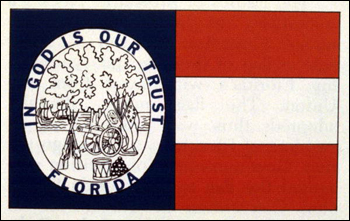
The purpose of this guide is to identify and describe the state, federal, and private records pertaining to Florida’s Civil War era (1860-1865) housed at the State Archives of Florida. We hope this guide will assist and promote research into this time period.
Government Records
RG 101 Florida Governor
This record group contains the records of the governors from Florida's admission to the United States as a territory in 1821 through Governor Martin's Administration, 1925-1929.
S 32 Territorial and State Governors letterbooks,1836-1909
83 volumes
Summary:
The series contains the official outgoing correspondence, in bound letterpress volumes, of Florida's territorial and state governors from 1836-1909. Included are the Civil War governors John Milton (1861-1865) and A. K. Allison (1865). All the letterbooks are originals except for Volume 6 (John Milton, 1861-1862) which is a photocopy. The original is located at the Florida Historical Society’s Tebeau-Field Library in Cocoa, Florida.
S 577 State governors' incoming correspondence, 1857-1888
3 cubic ft.
Summary:
The series contains the official incoming correspondence of Florida's governors from 1857-1888. For the Civil War-era, relevant material would include the incoming correspondence of Governors Madison S. Perry (1857-1861); John Milton (1861-1865); and David S. Walker (1865-1868).
RG 137 State Board of Pensions
The State Board of Pensions was established by law on February 16, 1885 and consisted of three members: the Governor, the Comptroller, and the Adjutant General. The Board dealt solely with Confederate pensions and was also referred to as the Board of Confederate Pensions. After 1915, the Treasurer took the place of the Adjutant General as the third member. The Board was responsible for creating the rules and regulations necessary for carrying out the state's pension laws and for reviewing the claims of individuals applying for pensions. The Board was required to report to the Governor prior to the meeting of the Legislature. In 1969, the Board's functions were transferred to the Division of Personnel and Retirement, Dept. of Administration.
S 407 Minutes,1886-1963
4 volumes
Summary:
This series contains minutes of both regular and special meetings of the State Board of Pensions from 1886 to 1963. The Board reviewed the claims of those individuals applying either as pensioners or widows. Information in the minutes include the name of the applicant, military unit served in, facts supporting the need for pension, date and place of marriage, and whether or not pension was awarded. Also included are legal opinions and resolutions concerning pension administration.
S 452 Correspondence, 1885-1960
3.5 cubic ft.
Summary:
The series contains correspondence, reports, lists, and other related materials which document the functions of the State Board of Pensions from 1885 to 1960. The correspondence is divided into five major areas: 1) general correspondence, 2) Adjutant General correspondence, 3) living widows correspondence, 4) National Archives correspondence, and 5) miscellaneous correspondence.
The general incoming correspondence from 1885 to 1959 is mainly from applicants or pensioners concerning eligibility, proof of service, requests for application, and requests for increases in the pension stipend. In some instances the individual letter has a summary typed on the back, the date of reply by the Board, and the corresponding page number in the letterbooks (Series 1295).
The Adjutant General correspondence from c. 1908 to 1956 contains mostly form letters from the State Board of Pensions to the United States Adjutant General's Office requesting proof of service for soldiers who had applied for a pension or for widows who had applied under a husband's name. The reply from the United States Adjutant General's Office is on the reverse side of the form.
Other correspondence in the series relates to inquiries regarding pensions from living Civil War widows, correspondence between the Board and the National Archives regarding pension requests and a project to microfilm the pension records, and miscellaneous files relating to various subjects.
S 456 Indexes of pension claims, 1907-1917
4 volumes
Summary:
This series consists of four volumes containing various indexes to the Confederate pension claims. The first two volumes contain a listing of claims filed and approved under the Act of 1909 and the Act of 1913. Each applicant's name, address, county, file number and certificate number is included. Information concerning the status of the claim includes the date of filing, amount allowed per year, date payable from and date of approval by the Board. Volume 3 contains an index of pensions filed under the Acts of 1907, 1909, 1913, 1915, and 1917. It is not known if this index is complete. Volume 4 contains a listing of purported deserters who may have initially received a pension and then had it withdrawn.
S 587 Confederate pension application files, 1885-1954 [This collection is available online]
113 cubic ft.; 107 microfilm reels
Summary:
This series includes files on approved and denied pension claims from 1885 to 1954. Most files contain the original application, any supplemental applications, proof of service and residency, and occasional correspondence between the applicant and the Board. Veterans' applications generally include name, date and place of birth, unit dates and places of enlistment and discharge, brief description of service, wounds received, sworn statements on proof of service by comrades, War Department service abstracts, and place and length of Florida residency. Widows' applications generally include, in addition to the above, her full name, date and place of marriage to the veteran, and date and place of the veteran's death. Widows' applications are filed under the name of the veteran. All the pension files have been scanned, and are available online for free.
S 1295 Letterbooks, 1887-1905.
9 volumes
Summary:
The series consists of nine bound letterbooks of outgoing correspondence of the State Board of Pensions from 1887-1905. In some instances the incoming correspondence has been tipped in the letterbook. The correspondence mainly answers inquiries from pensioners and applicants concerning eligibility, proof of service, the application process, and reasons for the denial of certain claims. Each volume contains a name index of correspondents. The first two volumes (1887-1888) contain both Pension Board and Adjutant General correspondence, dating from the period when Adjutant General David Lang served as Secretary of the Pension Board. Correspondence from August 28, 1895 to February 17, 1897 (Volume 7) is missing and only the index remains. There is also a gap in the records from January 20, 1900 to August 28, 1903.
RG 151 Office of the Secretary of State
The post of Secretary of State was originally created in the 1838 Constitution as the successor office to the Secretary of the Territory. The Office of Secretary of State was created in 1845 to maintain the state's public records. The Secretary of State was one of the elected Cabinet posts until January 3, 2003, when a constitutional amendment eliminating the office from the Cabinet and making the department responsible to the governor, with the Secretary of State position a gubernatorial appointment took hold.
S 24 Secretary of the Territory and Secretary of State letterbooks, 1830-1865, 1889-1905, 1922-1926
22 volumes
Summary:
The series contains the outgoing correspondence of the Secretary of State and the Secretary of the Territory from 1830-1865 and 1889-1905. (A major gap exists in the series from 1866-1888.) Housed in letterbooks, the correspondence documents the various duties of the Secretary of State and provides an understanding of the internal working of the state and of the historical events of the time. In addition to the secretaries' correspondence are various proclamations of the Governor (especially those from Governor John Milton, who served from 1861 to 1865) and some official correspondence of the assistant Secretaries of State. The Secretaries incoming correspondence is located in Series 1325.
S 1325 Secretary of the Territory and Secretary of State incoming correspondence, 1831-1917
2.5 cubic ft.
Summary:
The series contains the incoming correspondence of the Secretary of State and the Secretary of the Territory from 1831 to 1917. Correspondence in this series touches on numerous aspects of the responsibilities of the Secretary of State. Much of the correspondence is routine in nature, reflecting the secretary's statutory functions. The correspondence focuses on commissions, oaths and bonds of local officials, local election returns, the issuance of election certificates, recommendations for the appointment of officials, and publications and reports.
RG 171 Florida Military Department
The Military Department was created in 1921, it was directed by the Adjutant General, and its headquarters were in St. Augustine. The state militia has existed since territorial days, becoming the Florida State Troops in 1887 and the Florida National Guard in 1909. The Military Department and the Adjutant General controlled the Florida units of the National Guard; supervised all the arms, troops, branches, and stores of the Guard; and transported and supported any armed forces required by the state to maintain law and order. The Military Department became the Department of Military Affairs in 1973.
S 1210 Confederate Marine Corps and Navy personnel card roster of Floridians, 1925
.25 cubic ft.
Summary:
This series is a typescript card roster produced in 1925 of Confederate Marine Corps and Navy personnel who had connections with the State of Florida. The cards generally contain the place of birth, appointment, ranks, promotions, and military career. The cards were created by the staff of the Dept. during a project in 1925.
S 1425 Historical records, 1860-1945
2.5 cubic ft.
Summary:
This series contains historical information that illustrates the participation of Florida's Militia, National Guard, and private citizens in the wars of the United States, including the Civil War. These records include casualty notices, correspondence, and statistical reports that were generated at the Florida Adjutant General's Office and the service departments in Washington, D.C.
S 1725 Civil War recollections of S. M. Hankins, 1861-1865
.25 cubic ft.
Summary:
This series consists of a thirty-five page typescript entitled "My Recollections of the Confederate War," transcribed from the original "pencilled in longhand in an old account ledger." The recollections were written by Confederate veteran S. M. Hankins, and begin with Florida's secession in 1861, when Hankins was 14 years old. They recall Floridians' initial reactions to the threat of war; the raising of military units; the imprisonment of women and children and the burning of their homes if their husbands, fathers, or brothers were suspected of deserting; the shooting of deserters; the wartime treatment of African Americans; Hankins' enlistment at age 16; escorting prisoners to Andersonville; the Battle of Natural Bridge; and other wartime events.
RG 172 Office of the Adjutant General
The post of Adjutant General was first created by the Legislative Council of the Territory on February 1, 1832 and continued into statehood. The Adjutant General is appointed by the Governor and serves as his chief of staff (in the Governor's role as Commander-in-Chief). During the nineteenth century, the Adjutant General's duties included supervision of the state prison and quarantine of the coast. Between 1868 and 1885, the Adjutant General sat as a member of the Florida Cabinet. The Adjutant General also sat on the State Board of Pensions prior to 1915.
S 1147 Pay vouchers, 1862-1863
0.25, cubic ft., 1.00, microfilm reel (35 mm.)
Summary:
The series contains pay vouchers for some members of the Confederate Eighth Florida Infantry Regiment from 1862 to 1863. The Confederate Eighth Florida Infantry Regiment served in General Lee's Army of Northern Virginia from 1862 to 1865. Most of the documents record payments issued for service during a specified period. Some items, issued at the time of a soldier's discharge, give information such as birthplace, occupation, age, height, and complexion.
S 1273 Original Florida Confederate muster rolls, 1861-1865
60.00, item, 1.00, microfilm reel
Background:
Some 15,000 Floridians served in the Confederate Army during the Civil War. Florida troops were organized into 12 infantry regiments, two cavalry regiments, and a number of battalions, batteries, and independent companies. Most Floridians served outside the state during the war. The Second, Fifth, and Eighth Infantry Regiments (joined in 1864 by the Ninth, Tenth, and Eleventh Infantry Regiments) served in General Robert E. Lee's Army of Northern Virginia from 1862 to 1865. Another Florida Brigade served in the war's Western Theater. It was comprised of the First Cavalry Regiment and the First, Third, Fourth, Sixth, and Seventh Regiments of Infantry. The troops that remained in Florida fought at Olustee, Marianna, and Natural Bridge, and in a number of smaller skirmishes. During the Civil War, approximately 5,000 Floridians were killed or died from wounds or disease.
Summary:
These records document Floridians serving in Confederate military units from 1861 to 1865. The series includes both units mustered into Confederate service and those that remained in state service during the War. The muster rolls generally include: the name and rank of the soldier, when and where they enrolled, payroll information, and remarks. At the end of the series are non-unit rolls from the Chattahoochee Arsenal and the Warrington Naval Yard (Pensacola).
S 1279 Florida Confederate muster rolls, 1861-1865
37.00, v., 8.00 microfilm reels
Summary:
The volumes contain photostatic copies of muster in rolls, muster out rolls, descriptive rolls, annual, monthly, and quarterly returns, and special orders for Florida confederate soldiers from 1861 to 1865. The muster rolls may contain the following information: name and rank of soldier; when, where, and by whom they mustered or enrolled into service; last paid; and remarks. In addition, the descriptive rolls include city and county of birth, age, occupation, hair and eye color, complexion, and height.
S 1280 Florida Cavalry Regiments of the Union Army muster rolls, 1863-1865
10.00, v., 2.00, microfilm reel
Background:
During the Civil War, two regiments of cavalry were organized in the state to serve the Union Army. These units, the First and Second Florida Cavalry Regiments, consisted of elements from Florida's sizeable pro-Union minority, along with disaffected ex-Confederates. A large percentage of the men were deserters from Confederate service, while many of the unit's officers came from outside of the state.
The First Florida Cavalry was organized at Fort Barrancas (Pensacola) from December 1863 to August 1864. The unit operated in west Florida and southern Alabama during its enlistment. Elements of the First Florida Cavalry participated in various scouts and expeditions, among which were actions at Camp Gonzalez and near Pollard, Alabama; the expedition to Marianna, Florida; and the campaign against Mobile, Alabama. The regiment was mustered out of service in November 1865.
The Second Florida Cavalry was raised primarily at Key West and Cedar Key from December 1863 to June 1864. The unit was assigned to the District of Key West and the Tortugas, and saw continuous duty in east and south Florida. It was involved in expeditions or skirmishes at Pease Creek, Fort Myers, Tampa, Station Number 4, Bayport, Braddock's Farm, and St. Andrews Bay, as well as the St. Marks (Natural Bridge) campaign of March 1865.
Two other units documented in these records are the Florida Rangers and the First East Florida Cavalry. The Florida Rangers were a south Florida organization that was eventually absorbed into the Second Florida Cavalry. Little is known about the First East Florida Cavalry. This independent, company-sized unit was apparently organized around Jacksonville and at Hilton Head, South Carolina, in late 1864. The unit served in northeast Florida for the remainder of the war and was on occupation duty around Tallahassee in the summer of 1865.
Summary:
The volumes contain photostatic copies of muster in and muster out rolls, descriptive rolls, some annual, monthly, and quarterly returns, and special orders of federal Florida cavalry regiments from 1863 to 1865. The muster rolls may contain the following information: name and rank of soldier; when, where and by whom they were mustered or enrolled into service; last paid; remarks. In addition to the above information, the descriptive rolls also include city and county of birth, age, occupation, and information about hair and eye color, complexion, and height. Some of the records are barely legible.
RG 342 Treasurer’s Office
The Treasurer's Office was created in the 1838 Constitution, effective with statehood in 1845. The State Treasurer received all moneys which are paid into the State Treasury; paid all warrants drawn by the Comptroller on the State Treasury; kept detailed records of all transactions involving the State's money; and handled insurance matters related to his duties as Insurance Commissioner.
S 677 Confederate pension warrants paid, 1900-1914
5 volumes
Summary:
The series contains the ledgers maintained by the Treasurer's Office documenting the cashing in of Confederate pension payment warrants from 1900 to 1914. The information provided includes warrant number, date of issue, to whom issued, to whom paid, date of payment, and the amount of the warrant. It should be noted that this series does not have the pension number. These are ledgers of financial transactions rather than pensioner profiles.
RG 350 Comptroller’s Office
The post of Comptroller was created in the 1838 Constitution and implemented with statehood in 1845. The Comptroller succeeded the Territorial Auditor of Public Accounts and assumed his duties as the state's chief fiscal officer. The Comptroller's Office examined, audited, and settled all accounts, claims, and demands against the state. It supervised banking institutions, sale of securities, and collection of revenue and taxes. The Comptroller wrote warrants for payment against the state treasury and compiled annual reports for the Governor and Legislature on state expenditures and trust funds.
S 43 Territorial and state military expenditures, 1839-1869
1.5 cubic ft.
Summary:
The series consists of the Comptroller's Office records for territorial and state military expenditures from 1839 to 1869. The series contains the expenditure records for territorial militia companies, frontier guard units of Seminole Indian wars, Confederate military organizations, and local guard activities. The records include invoices, receipts, provision records, vouchers, payrolls, and requisitions for forage. These records provide information on some Florida military units not available elsewhere.
S 476 Confederate pension warrants issued, 1905-1913
7 volumes
Summary:
The series contains ledgers, dated 1905-1913, maintained by the Comptroller's Office which document the issuance of pension warrants upon submission of a claim or voucher by the pensioner. After the Comptroller examined, audited, and verified the voucher, he issued the warrant which authorized the Treasurer to pay the designated amount of money from a specific fund of the Treasury. The volumes contain the following information: to whom the warrant was issued; number of the warrant; date of issue; amount of the warrant; to whom paid; and date of payment. It should be noted that this series does not have the pension number. These are ledgers of financial transactions rather than pensioner profiles.
RG 510 Division of Recreation and Parks
The Florida Park Service was originally created in 1935 as the Board of Parks and Historic Memorials and administered within the Board of Forestry. The Park Service's first eight parks were designed and built by the Civilian Conservation Corps. In 1949, the Park Service became an independent agency, the Board of Parks and Historic Memorials. Its purpose was to administer and control the operation and development of the state parks and historic sites of Florida. In 1969, the Board was merged with the Outdoor Recreational Development Council to form the Division of Recreation and Parks under the Department of Natural Resources. The Division eventually moved to the newly created Department of Environmental Protection (DEP) in 1993.
S 1319 Fort Clinch exhibit materials, 1765, 1820-1940
1.5 cubic ft.
Background:
Four-hundred and twenty acres on Amelia Island were set aside in 1842 for the purpose of establishing a military post. Construction began on a fort in 1847 and continued through the outbreak of the Civil War. In 1850, the fort was named in honor of Brevet Brigadier General Duncan L. Clinch. Florida state officials seized the property in 1861 and placed it under Confederate control until March, 1863, when it was regarrisoned by Federal troops. In March, 1929, the fort was sold as it was no longer needed for military purposes. In 1935, the newly created Florida Park Service acquired the fort. The Civilian Conservation Corps (CCC) developed the park and partially restored the fort.
Summary:
The series contains exhibit materials from Fort Clinch State Park in Fernandina (Nassau County), Florida. It contains many documents relating to the Civil War, the history of Fernandina, and the history of Fort Clinch itself. Among the various items are: seventeen issues of the Southern Illustrated News, (April-November 1863), published in Richmond, Virginia; an enrollment list of the Fernandina volunteers, 1861, signed by future Confederate General Joseph Finegan; a muster roll of field, staff, and company officers of Colonel Joseph Finegan, Fort Clinch, April to November 1861; time roll of laborers employed at Fort Clinch, 1862-1863; estimate on costs of building a Florida ship canal; a broadside for a "Moonlight Excursion" on the Steamer Martha, August 17, 1886; clippings relating to the Civilian Conservation Corps Camp at Fernandina; copies of telegraph messages from 1861 relating to Florida's secession; a diary fragment detailing work done on Fort Clinch in 1865; and letters from 1866, regarding construction of Fort Clinch.
S 1951 Public relations and historical files, 1934-1964
3 cubic ft.
Summary:
This series contains the public relations and historical files maintained by the Office of the Director of the Florida Park Service in the 1950s and early 1960s for use as reference in answering the public's questions, requests, and concerns on park operation, policy, and history. The records were created by three separate directors and by the Chief of Education and Information office. Included are historical records for Fort Clinch, Fort Pickens, Yellow Bluff Historic Site, and Judah P. Benjamin Historic Memorial.
S 1954 Historical marker files, 1961-1968
.50 cubic ft.
Background:
One of the major functions of the Board of Parks and Historic Memorials was the identification and marking of historic sites. Such sites might include early towns, roads, banks, military forts, or historic events such as Civil War battles, constitutional conventions, or significant inventions. The Board’s Chief of Information and Education administered the historical marker program. Once a site was selected, a short historic essay was written, often authored by well-known Florida historians such as Samuel Proctor, William Warren Rogers, or Dena Snodgrass. Finally, a two-sided metal plaque would be erected on or nearby the historic site. Often a community or town would solicit such a marker from the Board.
Summary:
Arranged alphabetically by county, each file in this series documents a specific marker, including records such as correspondence, marker text and drafts, historic research, and sign specifications. Each file is labeled with the marker's title, marker number, and the county the site was located within. Along with historical information for each site, the records also provide a sense of popular perceptions of Florida history in the 1960s. The majority of the markers concern the Civil War and other military-related sites. The series is not complete: only files from Alachua through Gulf counties are present.
RG 650 Dept. of Legal Affairs
The Department of Legal Affairs was created in 1969 to perform the powers, duties and functions of the office of the Attorney General, the chief state legal officer. The Office of the Attorney General, which dates back to Florida’s Territorial government, renders legal opinions on request to government agencies; reports on laws; directs state attorneys; and receives supreme court reports. The Attorney General also appears on behalf of the state in all suits in the District Courts of Appeal and the Supreme Court in which the state has an interest. In 1969, the Office was transferred to the newly created Dept. of Legal Affairs.
S 632 Attorney General Opinions, 1859-1913, 1941-1948
4 volumes, 32 cubic ft.
Summary:
This incomplete series contains the official opinions of the Attorneys General of Florida. No records are extant from 1914 to 1940, and there are also some gaps in the records between the years 1859 and 1913. The opinions are in the form of correspondence addressed to the government official who requested the opinion or legal advice in writing on a matter related to their official duties. There are four bound volumes of opinions. For the Civil War era, see volume 1 is a handwritten letterbook which contains the opinions of Mariano D. Papy (1859-1860); John B. Galbraith (1861-1866); George P. Raney (1877-1881); and C. M. Cooper (1885-1886). Keep in mind that volume 1 is not indexed
RG 1000 State Constitution Records
The State of Florida has been governed by six constitutions, written in the years 1838, 1861, 1865, 1868, 1885, and 1968. This record group contains original constitutions and records documenting their development. The 1838 Constitution was written in order to provide for a government when the territory became a state. The document created a bicameral legislature; a four year term for the Governor; the posts of Secretary of State, Attorney General, Comptroller, and Treasurer; and a traditional three branch government The 1861 Constitution provided for Florida's governing as part of the Confederacy and cut the terms of the Governor and Cabinet to two years after the current office holders had left. The 1865 Constitution annulled the 1861 Ordinance of Secession, created the post of Lieutenant Governor, and would have elected the Cabinet officers, but it was superseded by the 1868 Constitution. The 1868 Constitution granted suffrage to males of all races and created the Board of Education and the posts of Lieutenant Governor and Superintendent of Public Instruction. The 1885 Constitution made elective the Cabinet posts of Secretary of State, Attorney General, Treasurer, Comptroller, Superintendent of Public Instruction, and the newly created Commissioner of Agriculture. In addition, the 1885 Constitution abolished the post of Lieutenant Governor. The 1885 Constitution was often amended until its revision 1968.
S 540 Florida Convention of the People Minutes, 1861-1862
1 volume
Background:
Pursuant to an Act of the Legislature approved November 30, 1860, Governor Madison S. Perry issued a proclamation calling an election on Saturday, December 22, 1860, for delegates to a Convention to address the issue of whether Florida had a right to withdraw from the Union. The Secession Convention met on January 3, 1861 in Tallahassee. John C. McGehee of Madison County was elected President. The Convention passed the Ordinance of Secession on January 10, 1861, declaring Florida to be "a sovereign and independent nation." The Convention ratified the Constitution adopted by the Confederate States of America on April 13 and adjourned sine die on April 27, 1861 unless convened by the president on or before December 25.
Since the Convention generally approved of Governor Perry's actions it made no move to interfere with his administration; however, when Governor Milton took office in October of 1861 and reversed some policies of his predecessor, a move was started to reconvene the Convention. President McGehee issued a proclamation on December 13 for the convention to meet on January 14, 1862, at Tallahassee. McGehee expressed concern over two matters: the state's finances and the powers of the Governor during wartime. To remedy the later, the members appointed an Executive Council of four men to share the executive authority because they felt that the powers of a wartime executive should not be placed in the hands of one man. The Convention adjourned sine die on January 27, 1862.
Summary:
The series contains the minutes of the Florida Convention of the People (commonly referred to as the Secession Convention). The minutes document the topics discussed and actions taken by the Convention from January 3, 1861 to April 27, 1861 and from January 14, 1862 to January 27, 1862. The minutes also contain reports presented to the members from various committees, resolutions, and the ordinance of secession.
S 1457 Florida Convention of the People Ordinances and resolutions, 1861-1862
1 volume
Summary:
The series contains the original handwritten ordinances and resolutions of the Florida Convention of the People (commonly referred to as the Secession Convention) from January 3 - March 1, 1861, April 18 - 27, 1861, and January 14 - 27, 1862.
The volume contains all the ordinances and resolutions passed by the Convention, except for the Ordinance of Secession (No. 1) which can be found in Series 972. A copy of the Constitution of the Confederate States of America is found after Ordinance 28 (the ordinance which ratifies it).
S 972 Florida Convention of the People ordinance of secession, 1861
1 item
Summary:
The series contains a one page handwritten copy of the Ordinance of Secession passed on January 10, 1861 by the members of the Florida Convention of the People (commonly referred to as the Secession Convention).
RG 1001 Florida Executive Council
The members of the Convention of the People (the Secession Convention) argued that the powers of the wartime executive should not be placed in the hands of one man, so they appointed an Executive Council of four men to share the responsibilities. James A. Wiggins, Mariano D. Papy, W.D. Barnes, and Smith Simpkins made up the Council. The Convention granted to the Governor and the Council certain powers to meet the crises of war. These included martial law; arresting disloyal persons; appropriating private property for public use; bringing any of the population into public service; securing arms and ammunition; creating new state agencies; and appointing military officers. The Council, however, met only five times between February 28 and May 24, 1862. In most instances, the Council gave Milton little opposition, thus negating the need for its existence.
S 82 Proceedings, 1862
.25 cubic ft.
Summary:
This series contains a "true copy' of the proceedings of the meetings of the Executive Council from February 28, 1862 to May 14, 1862. The proceedings were recorded by Governor Milton's executive secretary, E. Barnard. It documents the activities and decisions made by the Executive Council.
RG 1020 Federal Census records
The purpose of the federal census is to enumerate the entire population of the country every ten years by county jurisdiction. The first six federal censuses, those from 1790 to 1840, were overseen by federal marshals. The first Census Office began operation in Washington in 1850. This was only temporary as the Office was disbanded after each count. The Census Office became permanent in 1902.
The first six censuses were similar in content, naming only the heads of families. All other people were noted only by tally marks in categories for age, sex, race, and slavery, except that the Constitution excluded from the census all Indians not taxed. The later federal censuses included a variety of different schedules. The 1850 and 1860 censuses contained free population, slave population, mortality, agriculture, and industry schedules. The 1870 and 1880 counts included schedules for population, mortality, agriculture, and industry. The federal census was first compiled in Florida in 1830.
S 1489 Census of the District of Florida, 1864-1865
.50 cubic ft.
Background:
As an administrative measure the United States Army divided the nation into departments. The departments were established to control the military forces within certain geographic boundaries. Those areas that were captured while in rebellion were governed by military officers of the department rather than by civilian officials. The departments were named to reflect the geographic areas that they administered.
In 1864 the Department of the South was headquartered in the Hilton Head/Beaufort area of South Carolina. It included the Districts of Florida and Georgia as well as the District of South Carolina. The Union forces that comprised the District of Florida occupied the major population centers of the state.
Summary:
The series consists of portions of censuses that where conducted in the District of Florida during 1864 and 1865. These portions survey the residents of Jacksonville, St. Augustine, the St. Johns River area, Amelia Island, and Fernandina. The 1864 census was conducted in the Jacksonville, St. Augustine, and St. Johns area. It is divided by race and enumerates all persons by name, status of citizenship, place of birth, and whether the enumerated was a free person of color or "contraband". The status of contraband was applied to those persons who had been held in bondage but were now free or within the Union lines. Those persons enumerated as contraband also had the name of their former slave master recorded. The 1865 census is only for the Amelia Island area. It is limited to "colored" and notes relationships among the enumerated, ages, sex, former slave masters, where the person was held in bondage, and the enumerator’s occupation. Wives of men in the Union Army are also noted.
RG 1025 National Archives Microfilm Publications
This record group is comprised of copies of various microfilm publications from the National Archives and Records Administration pertaining to Florida history. Created in 1935, the National Archives and Records Administration (NARA), an independent Federal agency, is charged with preserving and managing Federal records. Today they house well over 2.9 million cubic as well as millions of photographs, maps, motion pictures, and audio recordings. Included are several series of Federal records relating to Florida’s participation in the Civil War.
S 981 Records relating to Confederate naval and marine personnel, 1861-1865
7 microfilm reels
Background:
During its short life, the Confederate Government, in addition to establishing a large army for defense, also organized a smaller naval and marine force. Confederate sailors manned a variety of river and coastal defense stations and vessels, as well as ocean-going raiders like the famous Alabama. In addition, a naval brigade was organized at the close of the war from the members of the James River Squadron; they participated in the Appomattox Campaign, eventually surrendering in Greensboro, North Carolina on May 1, 1865. Confederate Marine Corps detachments served aboard ships of the Confederate Navy and also in small shore detachments. Marines garrisoned Charleston, Mobile, Savannah, and Wilmington, and helped to defend Fort Fisher, North Carolina against Federal forces in early 1865. Unfortunately, few records of the Confederate Navy and Marine Corps survived the war. The fragmentary records in this collection represent the majority of such materials that still exist.
Summary:
The microfilm publication contains records relating to persons serving in the Confederate Navy and Marine Corps. These records are in three series, as follows: (1) compiled hospital and prison records of naval and marine personnel, (2) reference cards and papers relating to naval personnel, and (3) reference cards and papers relating to marine personnel. The first series, arranged alphabetically by surname of sailor or marine, consists of cards containing abstracts of entries relating to the individual in original Union and Confederate hospital registers, prescription books, and Union prison and parole rolls; and the originals of papers, primarily from prison records, relating to the individual. The second and third series consist of reference cards and the originals of any papers relating solely to a particular sailor or marine, arranged alphabetically by surname. The reference cards indicate the rank of the sailor or marine and contain references to vessel papers, payrolls, muster rolls, and volumes in the War Department Collection of Confederate Records.
S 982 Compiled service records of Confederate soldiers who served in organizations from the State of Florida, 1861-1865
111 microfilm reels
Summary:
This microfilm publication contains the compiled service records of Confederate soldiers belonging to units from the State of Florida. The compiled service records consist of a jacket-envelope for each soldier, labeled with his name, his rank, the unit in which he served, and often a statement concerning the origin or background of that unit. The jacket-envelope typically contains (1) card abstracts of entries relating to the soldier as found in original muster rolls, returns, rosters, payrolls, appointment books, hospital registers, Union prison registers and rolls, parole rolls, and inspection reports; and (2) the originals of any papers relating to the particular soldier. There are cross-reference cards and jacket-envelopes for soldiers' names that appear in the records under more than one spelling. An index to the compiled records can be found in Series 1504.
Also included in the series are the records of the 15th Confederate Cavalry which is not indexed in the original publication. This unit was organized directly by the Confederate Government. The records are arranged alphabetically by name of soldier. (Rolls 28-32).
In addition, the publication contains documents relating to soldiers form Florida selected from the "Unfiled and Unfileable" series of the War Department Collection of Confederate Records. These papers are also arranged alphabetically and are not indexed. (Rolls 119-120)
S 989 Compiled military service records of General and Staff Officers from the State of Florida, 1861-1865
5 microfilm reels (16 mm)
Summary:
This microfilm publication contains the military records of general and staff officers who served in the Confederacy from the State of Florida. These records include correspondence, receipts, registers of appointments, payroll records, etc.
S 1300 Letters sent by the Department of Florida and successor commands, 1861-1869
2 microfilm reels (35 mm)
Summary:
This microfilm publication contains seven volumes of letters sent by the Department of Florida and its successor commands from April 1861 to January 1869. The letters and reports were dispatched by the commanding officers and their adjutants from department and district headquarters. Some overlapping of dates between volumes 6 and 7 exists. But there is no duplication of letters. A few of the letters bear nonconsecutive identifying numbers.
S 1301 Case files of applications from former Confederates for presidential pardons: Amnesty papers, 1865-1867
1 microfilm reel (35 mm)
Summary:
This microfilm publication consists of applications for pardon, submitted to President Andrew Johnson by former Confederates from the State of Florida who were excluded from the provisions of his amnesty proclamation of May 29, 1865. The majority of applications are unsworn statements by petitioners, but there is a large number of statements sworn before a magistrate. Included with each application is an oath of allegiance signed by the petitioner and in many cases, recommendations from prominent citizens for clemency or letters from relatives or friends containing pleas for compassion. The individual files often contain considerable information on a pardon applicant's background, his activities during the war years, and his attitude in defeat. Filed at the end of the alphabetically arranged records are miscellaneous files relating to the business of pardoning.
S 1313 Consolidated index to compiled service records of Confederate soldiers, 1861-1865
535 microfilm reels (16 mm)
Summary:
This microfilm publication contains the "consolidated" or master index of all the names of Confederate soldiers found in the records used in compiling the service records for each soldier, regardless of whether the service was with a unit furnished by a particular State, with a unit raised directly by the Confederate Government such as the 1st Confederate Infantry or the 1st Regiment of Engineer Troops, or as a staff officer. Each card gives the name of the soldier, his rank, the unit in which he served, and often a statement concerning the origin or background of that unit. There are cross-reference cards for soldiers' names that appeared in the records under more than one spelling.
S 1504 Index to compiled service records of Confederate soldiers who served in organizations from the State of Florida, 1861-1865
9 microfilm reels (16 mm)
Summary:
This microfilm publication contains the alphabetical card index to the compiled service records of Confederate soldiers belonging to units from the State of Florida. The index contains most of the names of Florida soldiers to which references were found in the records used in compiling the service records. The cards give the name of the soldier, his rank, the unit in which he served, and often a statement concerning the origin or background of that unit. There are cross-reference cards for soldiers' names that appeared in the records under more than one spelling.
S 1563 Compiled service records of Confederate general and staff officers, and non-regimental enlisted men, 1861-1865
275 microfilm reels (16 mm)
Summary:
This series contains the microfilm publication of the compiled service records of Confederate officers and enlisted men who did not belong to any particular regiment, separate company or comparable unit, or special corps. This class of military personnel included general officers; officers and enlisted men of the so-called staff departments; members of army corps, division, and brigade staffs; and various appointees with special status such as aides-decamp, military judges, chaplains, agents and drillmasters.
The so-called staff departments were those of the Adjutant and Inspector General, the Quartermaster General, the Commissary General, the Medical Department, and the Ordnance Department. The index for series 1563 is in series 1313, "The Consolidated Index to Compiled Service Records of Confederate Soldiers."
S 1567 Confederate States Army casualties lists and narrative reports, 1861-1865
7 microfilm reels (35 mm)
Summary:
This microfilm publication reproduces part of the unbound lists and narrative reports of casualties submitted by the Confederate States Army to the Confederate War Department during the Civil War. The records are generally nominal lists of casualties that were not published in the Official Records as a matter of policy, statistical lists from which abstracts were compiled and published, and narrative reports that were not published for such reasons as the relative unimportance of the reporting unit. The lists and reports reproduced in this publication contain some errors. For example, the spelling of the name of an individual on a list or report does not always agree with the spelling on muster rolls and payrolls. This kind of error may have occurred when lists were prepared without access to the rolls or other reliable headquarters personnel records.
S 1845 Register of Confederate soldiers, sailors, and citizens who died in federal prisons and military hospitals in the north, 1861-1865
1 microfilm reel
Summary:
This microfilm publication reproduces a 665-page register compiled in 1912 in the Office of the Commissioner for Marking the Graves of Confederate Dead which is now a part of the National Archives, Records of the Office of the Quartermaster General, Record Group 92. The register provides the names of individuals, their rank, company, regiment, date of death, number and location of grave, and the prison camp or other location where they died.

 Listen: The Assorted Selections Program
Listen: The Assorted Selections Program